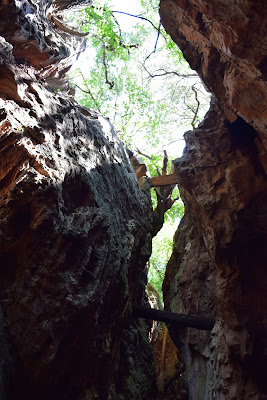The Cradle of Humankind is a UNESCO World Heritage site responsible for more than a third of early hominid fossils ever found prior to 2010. The limestone caverns are open to the surface via small holes where early hominins may have fallen to their deaths and became encased in a mixture of limestone and other sediments called breccia and fossilized over time. We toured an introductory exhibit and then entered the Sterkfontein Caves.
During the gold rush, miners needed limestone to refine and condition gold and other metals. So they tore out all the easy to access stalactites and stalagmites, which leaves the cave looking a little more like a mine and less like a cave. There are still limestone formations along the walls, and an underground lake with blind fish.
The lake has never been fully explored.
After emerging from the dark caves, we proceeded to the museum for a very nice buffet lunch and a tour of the museum, complete with a water ride through geologic time.
We hiked the area around the museum, which was home to Bantu pastoral farmers since the Early Iron Age (AD 300) followed by armed colonial settlers who seized the land in the late 1800s.
#CSCZA19 #IBMCSA
During the gold rush, miners needed limestone to refine and condition gold and other metals. So they tore out all the easy to access stalactites and stalagmites, which leaves the cave looking a little more like a mine and less like a cave. There are still limestone formations along the walls, and an underground lake with blind fish.
The lake has never been fully explored.
After emerging from the dark caves, we proceeded to the museum for a very nice buffet lunch and a tour of the museum, complete with a water ride through geologic time.
We hiked the area around the museum, which was home to Bantu pastoral farmers since the Early Iron Age (AD 300) followed by armed colonial settlers who seized the land in the late 1800s.
#CSCZA19 #IBMCSA













Comments
Post a Comment